Gynecology & Obstetrics
Open Access
ISSN: 2161-0932
ISSN: 2161-0932
Review Article - (2019)Volume 9, Issue 5
Objective: AUB is one of the most serious problems that face females all over the world not only through their reproductive age but also after menopause. This study aims to determine the types and frequencies of pathological causes of AUB in Upper Egypt women aged in different age groups and to study the necessity and significance of endometrial curetting in abnormal uterine bleeding.
Methods: A Retrospective study carried out on 676 specimens obtained by from patients with AUB. Data is being received from clinical and pathological records at Assuit University Hospital covering the period of 3 years from April 2015- April 2018. The total tissue submitted was processed and examined in details microscopically by the pathologist.
Results: A total of 676 cases with AUB, Endometrial polyp seen in 37.9% (the most common). Leiomyoma was seen in 9.2%. Complication of pregnancy (8%), disordered proliferative endometrium (6.8%), adenomyosis (5.9%), proliferative endometrium (4.7%), endometritis (4.1%), Abnormal secretory phase pattern (2.1%), simple hyperplasia without atypia (3.6%) and complex hyperplasia with atypia (6.2%). Both secretory endometrium and endometrium with evidence of exogenous hormone therapy had the same percentage (2.4%). Finally, malignancy was seen in (5.3%) cases.
Conclusion: We conclude that Endometrial polyp, endometrial hyperplasia, and Leiomyoma represent the most common causes of abnormal uterine bleeding in Egyptian women, so as organic causes of abnormal uterine bleeding represent a high percentage, we can say that endometrial curetting and biopsy as a diagnostic procedure has an important role in AUB patients. Histological diagnosis of different pathologies help in their treatment easily once diagnosed and also helps in prophylaxis against malignancy transformation and progression.
Endometrial polyp; Leiomyoma; Endometrial hyperplasia; Endometrial carcinoma
Abnormal Uterine Bleeding (AUB) is defined as any variation from the normal menstrual cycle, including alteration in its regularity, frequency of menses, duration of flow, and amount of blood loss [1].
AUB is one of the most serious problems that face females all over the world not only through their reproductive age but also after menopause. About one-third of all females visiting gynecologists complaining from AUB [2]. Although menorrhagia is the most common form of AUB, it may take many other forms as metrorrhagia, menometrorrhagia, polymenorrhagia, etc [2].
Successful management of a case of AUB needs an accurate identification of the cause. The cause of AUB may be so simple as a physiological process but on the other hand, it may be so serious as malignancies. It may be due to fibromyoma, adenomyosis, endometrial polyp, ovarian tumor, Pelvic Inflammatory Disease (PID), endometrial hyperplasia, endometrial carcinoma, hormonal imbalance (like hypothyroidism) [1].
In many patients, AUB occurs without any obvious systemic causes or any organic lesions of the genital tract and for this, the term dysfunctional uterine bleeding (DUB) is used (by histopathology this type of is bleeding caused by many disorders as disordered proliferative endometrium, abnormal secretory phase pattern, etc) [3].
This study aims to determine the types and frequencies of pathological causes of AUB in Upper Egypt women aged in different age groups and to study the necessity and significance of endometrial curetting in abnormal uterine bleeding.
This study is a descriptive retrospective study carried out on 676 specimens obtained by from patients with AUB. Data is being received from clinical and pathological records at Assuit University Hospital covering the period of 3 years from April 2015-April 2018.
The study parameters include age, clinical features, type of the specimen including dilatation and curettage (D and C), endometrial biopsy, fractional curettage, and different hysterectomy specimens had been sent to the pathology laboratory for evaluation and histopathological findings. The total tissue submitted was processed.
Paraffin blocks were prepared and tissue section (4 m to 6 m) cut. The sections were stained with hematoxylin and eosin stain (H and E) and examined in details microscopically by the pathologist.
The collected data were submitted to descriptive statistical analysis.
A total of 676 cases with AUB (18 to 85 years, the mean age of 41.26 years) women underwent sampling at the Assuit University Hospital over a 3‑year period. The presenting clinical features of these patients are summarized in Diagram 1.
The most common clinical presentation was represented by menorrhagia 236 cases (39.9%) followed by polymenorrhea 124 cases (18.3%) and the least clinical presentation was oligomenorrhea 12 cases (1.8%).
The histopathological evaluation of the specimens received (382 cases by D and C, 182 cases by hysterectomy, 96 cases by endometrial biopsy and 16 cases by fractional curettage) revealed various patterns (Table 1).
| No of patients | Percentage | |
|---|---|---|
| Proliferative | 32 | 4.7 |
| Secretory | 16 | 2.4 |
| Abnormal secretory phase pattern | 14 | 2.1 |
| hormonal therapy effect | 16 | 2.4 |
| Disordered proliferative | 46 | 6.8 |
| Complication of pregnancy | 54 | 8 |
| Atrophy | 10 | 1.5 |
| Polyp | 256 | 37.9 |
| Endometritis | 28 | 4.1 |
| Endometrial hyperplasia without atypia | 24 | 3.6 |
| Endometrial hyperplasia with atypia | 42 | 6.2 |
| Adenomyosis | 40 | 5.9 |
| Leiomyoma | 62 | 9.2 |
| Malignancy | 36 | 5.3 |
| Total | 676 | 100 |
Table 1: Histopathological distribution of cases in patients of AUB.
The PALM‑COEIN (polyp; adenomyosis; leiomyoma; malignancy and hyperplasia; coagulopathy; ovulatory dysfunction; endometrial; iatrogenic and not yet classified) classification system for AUB has been recently approved as a FIGO classification system.
The aim of this classification system is to facilitate communication, clinical care, and research for clinicians, investigators, and even patients (Figure 1) [4].
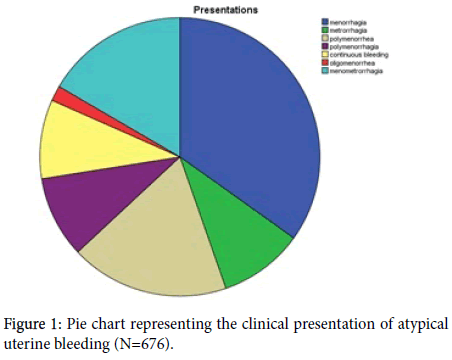
Figure 1. Pie chart representing the clinical presentation of atypical uterine bleeding (N=676).
Endometrial polyp seen in 256 cases (37.9%) was the most common (Figure 2). Leiomyoma was seen in 62 patients (9.2%) (Figure 3).
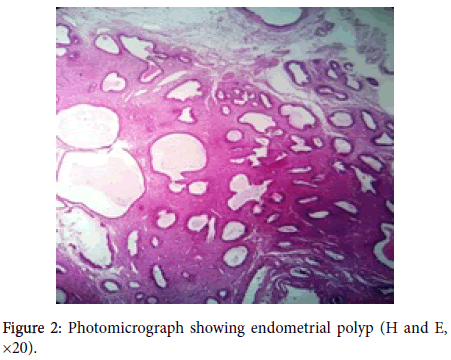
Figure 2. Photomicrograph showing endometrial polyp (H and E, ×20).
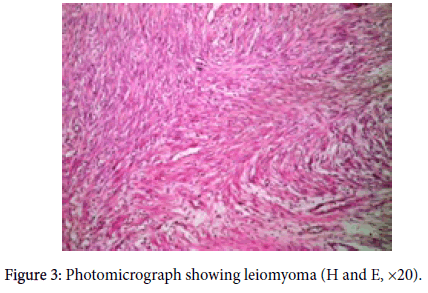
Figure 3. Photomicrograph showing leiomyoma (H and E, ×20).
The other diagnoses, which accounted for the rest of the atypical uterine bleeding, were complication of pregnancy 54 cases (8%), disordered proliferative endometrium 46 cases (6.8%), adenomyosis 40 cases (5.9%), proliferative endometrium 32 cases (4.7%), endometritis 28 cases (4.1%) and Abnormal secretory phase pattern 14 cases (2.1%).
Endometrial hyperplasia was seen in 66 (9.8%) patients who presented with atypical uterine bleeding, simple hyperplasia without atypia was seen in 24 cases (3.6%) and complex hyperplasia with atypia in 42 cases (6.2%) (Figure 4).
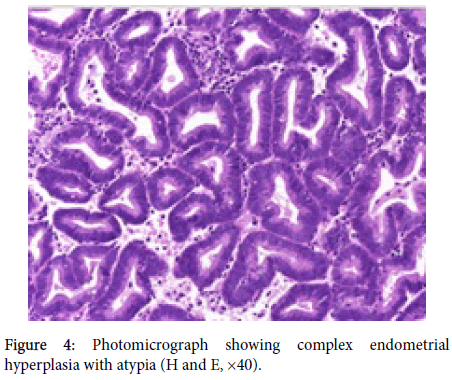
Figure 4. Photomicrograph showing complex endometrial hyperplasia with atypia (H and E, ×40).
Both secretory endometrium and endometrium with evidence of exogenous hormone therapy, which is a common line of medical management in patients of atypical uterine bleeding had the same percentage (2.4%).
Finally, malignancy was seen in 36 cases (5.3%) cases (Figure 5).
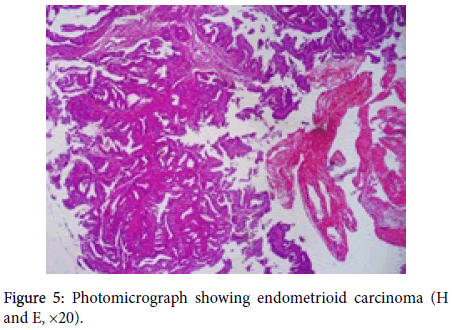
Figure 5. Photomicrograph showing endometrioid carcinoma (H and E, ×20).
Abnormal uterine bleeding is one of the most frequently encountered complaints in gynecologic practice. It forms more than 70% of all gynecological consultations in the peri and postmenopausal years [5]. This study attempts to analyze cases of abnormal uterine bleeding among women in the 18-85 age group.
According to the results of our study, the commonest clinical presentation was menorrhagia (39.9%). Similar findings were shown by Jairajpuri et al. and Mughal [6,7] as it was 41% in both studies. Similarly, menorrhagia was the commonest in the study of [1] as it was about 48.6%. The study conducted by Rifat et al. [8] reported 42.7% of cases with menorrhagia, which is slightly more than our study. The second commonest presentation in our study was polymenorrhea 124 cases (18.3%) as seen in the study of Kotagasti [9].
Regarding histopathological findings, Endometrial polyp seen in 256 cases (37.9%) and that in contrast with [6] where polyp found in (1.7%) only and [10] where polyp represents about 2.7%. The study conducted by Kumaresan et al. [11] revealed polyp represent 10% of cases.
Leiomyoma is a common finding in females with AUB. The abnormal bleeding in fibroids occurs due to the increased size of uterine cavity which leads to increase in the surface area of the endometrium, vascular alterations of the endometrium and obstructive effect of fibroid on uterine vasculature leading to endometrial venule ectasia and congestion in the myometrium and endometrium [12]. In our study Leiomyoma was the second etiology of AUB forming 62 (9.2%) of cases, this is in the agreement of study done by Rizvi et al. [12].
DUB is a disorder due to hormonal imbalance without an organic cause. Abnormalities along the hypothalamic-pituitary-ovarian axis may lead to derangements of follicular maturation, corpus luteum formation or ovulation resulting in changes in the hormones which lead to abnormal uterine bleeding.
We found that disordered proliferative endometrium represents the most common cause AUB among DUB causes (6.8%), also study [10] by having the same result. Endometritis had a significant pathological etiology of AUB in our study and diagnosed in 28 (4.1%) cases as the study was reported [13,14]
Finally, endometrial hyperplasia and malignancy represent significant percentage among causes of AUB as they were 9.8% and 5.3% respectively and this result is in parallel to results of Litta et al. [15], so biopsy has a significant role in diagnosis, prophylaxis against malignancy transformation and progression.
We conclude that Endometrial polyp, Endometrial hyperplasia, and Leiomyoma represent the most common causes of abnormal uterine bleeding in Egyptian women, so as organic causes of abnormal uterine bleeding represent a high percentage, we can say that endometrial curetting and biopsy as a diagnostic procedure has an important role in AUB patients. Histological diagnosis of different pathologies help in their treatment easily once diagnosed and also help in prophylaxis against malignancy transformation and progression.
Citation: Badary DM, Taleb HA, Samir HA, Allah AA (2019) Histopathological Spectrum of Abnormal Uterine Bleeding in Upper Egypt: A Study of 676 Cases. Gynecol Obstet (Sunnyvale) 9: 505.
Received: 11-Nov-2018 Accepted: 22-May-2019 Published: 28-May-2019
Copyright: © 2019 Badary DM, et al. This is an open-access article distributed under the terms of the Creative Commons Attribution License, which permits unrestricted use, distribution, and reproduction in any medium, provided the original author and source are credited.
Sources of funding : N/A